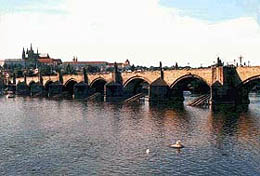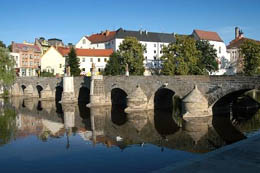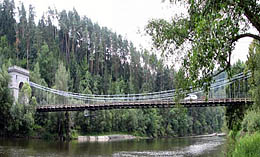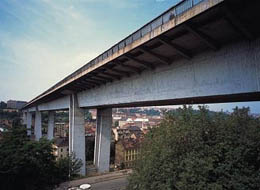
Mosty in the Czech Republic: the most famous is Charles Bridge, the oldest is in Písek
 |
It is the second oldest preserved bridge in the Czech Republic. It replaced Judith Bridge, which was destroyed in 1342 during a flood. Its construction began in 1357 under the auspices of King Charles IV and was completed in 1402. Originally, it was called the Stone or Prague Bridge. The name Charles Bridge became established around 1870 at the earlier initiative of Karel Havlíček Borovský. It is 515 meters long and its width is 9.4 to 9.5 meters. The height of the roadway is 13 meters above the normal level of the Vltava River. It consists of 16 arches. It was adorned with 30 predominantly Baroque sculptures and supplemented with three towers.
 |
The oldest bridge in the Czech Republic competes for the title of the oldest bridge in Central Europe with the bridge in Regensburg, Germany, which was completely destroyed during a flood and rebuilt. The Písek bridge was built around 1300, but the first records exist only from 1348. It is 109.8 meters long and 6.3 meters wide. The bridge over the Otava River stands on six pillars and consists of seven arches. It is built in the Gothic style, with Baroque sculptures and a cross placed on it. During the floods in 2002, water washed away some of its components.
 |
It is one of the most modern bridges in the Czech Republic. It was built from 1994 to 1998 according to the designs of architect Roman Koucký and quickly became one of the symbols of the city. In 2001, the bridge was ranked among the ten most beautiful world structures of the last decade of the 20th century in an international survey by the renowned magazine Structural Engineering International. The 198-meter-long bridge stands out primarily for its triangular suspended structure.
 |
The only preserved chain suspension bridge in the Czech Republic is a significant technical monument. It was built between 1847 and 1848 in the then fashionable Empire style over the valley of the Vltava River near the village of Podolí. In 1960, before the filling of the Orlík Reservoir, it was disassembled for preservation and later reconstructed from its original parts near the village of Stádlec over the Lužnice River. The bridge measures 157 meters and was reopened in 1974.
 |
The largest single-arch steel bridge in the country and a significant landmark of the central Povltaví was constructed in stages from 1958 to 1967. It was named after a nearby settlement that was submerged during the filling of the Orlík Reservoir. The total length of the arch is 542.9 meters, with the span between the supports reaching 379.6 meters. The roadway is about 50 meters above the water level. At the time, it was the world's top single-arch bridge; today, it ranks roughly eighth.
 |
A reinforced concrete bridge with six lanes that connects Pankrác and the more distant southwestern parts of the city with Karlov and the city center was completed in 1973. It is part of the north-south expressway. The bridge is 485 meters long and 26.5 meters wide. It has four piers and rises on average 42.5 meters above the valley. The inner tunnel for the metro has a height of nearly 6.5 meters. The tallest bridge in Prague is unfortunately infamous as a suicide hotspot.
The English translation is powered by AI tool. Switch to Czech to view the original text source.
0 comments
add comment
Related articles
0
23.09.2020 | The region has started repairing the Stádlecký Bridge, the work will last for two months
0
14.09.2016 | The Žďákovský Bridge has spanned the Orlická Dam for 50 years
0
22.05.2015 | The same bridge has been over the Vltava for 112 years, now it has been over the Lužnice for 40 years
0
29.11.2011 | The Žďákovský Bridge will undergo a general renovation
0
24.05.2010 | 25 years ago, the Empire chain bridge near Stádlec was reopened












